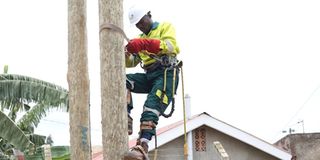Counting cost of suspending electricity connection policy

Electricity connectivity has become impossibly expensive ever since the suspension of the electricity connection policy in December. PHOTO | file
What you need to know:
The suspension of the electricity connection policy, which had been subsidising new applications has made new electricity connections almost impossible dropping by 90 per cent since December last year, writes Christine Kasemiire.
Electricity poles are molding somewhere in Isingiro, south west of Kampala. It had been hoped that there would be means to extend power to households.
But now that the electricity connection policy (ECP), which had been subsidizing connections was suspended, the poles are greying.
It is not isolated to Isingiro, it is happening elsewhere after government in December amended the policy, which required all customers seeking to be connected to fully meet the connection bill.
The amendment meant that electricity connections, which had been costing an average of Shs20,000 for inspection, jumped to Shs720,883 for a no pole connection, Shs2.3m for one pole bare conductor and Shs2.7m for pole with insulated conductor connection.
As a result, Umeme, the main power distributor, which registered 1,000 applications per day under ECP, has now recorded nearly 90 per cent drop in new applications.
“Total applications under customer funded connections from December 10, 2020 to January 7 2021 were 4,839. 1,767 customers have been connected within an average of four days. Out of the 1,767 funded connections made, 964 (54 per cent) are new applications while 803 (45 per cent) were pipeline ECP connections,” says Peter Kaujju, the Umeme head of communications and corporate affairs. Other distributors such as Uganda Electricity Distribution Company Limited have received only 50 applications in a month.
This comes as no surprise because the reality is the cost of connection is far expensive for many and beyond their pay grade.
According to Uganda Bureau of Statistics 2019 statistical abstract, the median monthly salary for about 15 million Ugandans under paid employment is Shs176,000 in 2016 while unemployment rate is 9.2 per cent.
Shambolic state of affairs in electricity sub-sector
While the number of people applying for electricity is dipping, the country’s electricity generation capacity is 1,254 Megawatts (MW) against 600 MW of peak demand.
Meanwhile more dams including the 600 megawatt (MW) Karuma Hydro Power plant are being constructed to produce more power.
Already, the existing dams are underutilized, costing taxpayers billions of shillings for capacity charges.
Also, the dams are stock piling the country’s debt, which eventually has to be paid by taxpayers.
Yet, the current power tariffs prove burdening to different customers who make it a point to plea for a reduction at every public gathering graced by sector players.
Possible Solutions
David Mugisha, an energy researcher and economist, believes government should abandon tariff raising items in the new Umeme concession under negotiation.
“In the renegotiation, electricity consumers should stop paying Umeme’s corporate income tax. Umeme should also begin to treat energy losses as part of their profit or loss accounts such that at the point of Uganda Revenue Authority, energy losses should have already been catered for. The electricity consumer should not meet the cost of especially technical losses,” he notes.
Mugisha also says government should abandon the cost reflective tariff methodology and instead reduce the cost of electricity for all Ugandans to rely on economies of scale to increase power demand.
“We have invested a lot in distribution networks, dams and transmission lines, the current consumer cannot afford it. Let’s reduce the tariff deliberately such that more people can consume electricity, am talking about current connections,” he says.
“We have sufficient current connections that can consume all this power. When they reduce the power to say Shs400 from Shs780 and Karuma and isimba come onboard, it means people who have been using charcoal for cooking can now use electricity. We consume all that power such that we meet all the costs of the sector.”
Creating alternatives
Electricity Regulatory Authority says lowering tariffs require loans to the sector such that recovery of the costs is deferred.
“The sector does not accrue any profit apart from those returns that were predetermined by government. Whatever is in the price of electricity is the cost of delivering the service. Indirectly that move would mean you want distribution or transmission to stop,” Ziria Tibalwa, ERA chief executive officer, says.
Tibalwa has faith that government initiatives such as the rebate policy and credit extensions to electricity consumers will work to grow domestic customer demand while creation of industrial parks boost industrial demand.
“For the rebate policy, we are in more than 50MW of projects that we have approved. They are around seven projects. We are putting in place innovative ways to ensure that the public accesses clean energy. For example, we are finalising the pilot of converting cooking with firewood to electricity. Once the pilot proves worth it, we shall roll out to hospitals, schools and gradually to domestic customers. All those interventions will enable us go where we want to be in the foreseeable future,” she says.
However, most initiatives especially those under Rural Electrification Agency, just like ECP are donor funded which has proved unsustainable, calling for more self-sufficiency.
Funding of ECP fell short due to occurrence of a pandemic which altered donor financing to the much urgent health emergency.




